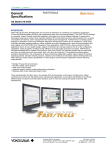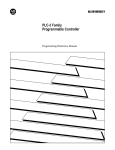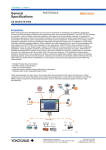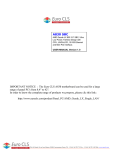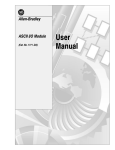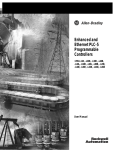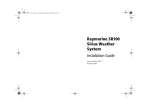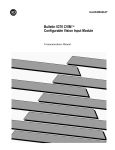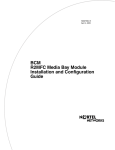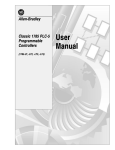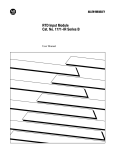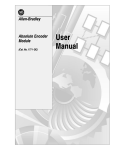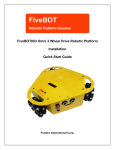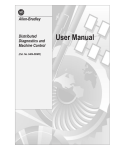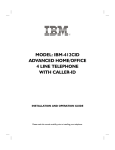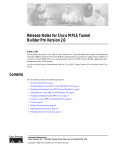Download 1761-6.5.27, Direct Communication Module User Manual
Transcript
AllenBradley Direct Communication Module (Cat. No. 1771-DCM) User Manual Table of Contents To Our Customers . . . . . . . . . . . . . . . . . . . . . . . . . . . . . . . 11 To Our Customers . . . . . . . . . . . . . . . . . . . . . . . . . . . . . . . . . . . Manual's Purpose . . . . . . . . . . . . . . . . . . . . . . . . . . . . . . . . . . . Intended Audience . . . . . . . . . . . . . . . . . . . . . . . . . . . . . . . . . . . Terminology . . . . . . . . . . . . . . . . . . . . . . . . . . . . . . . . . . . . . . . . Related Publications . . . . . . . . . . . . . . . . . . . . . . . . . . . . . . . . . . 11 11 11 11 11 Overview of Direct Communication Module . . . . . . . . . . . . 21 Overview of Direct Communication Module . . . . . . . . . . . . . . . . . . Describing the 1771DCM . . . . . . . . . . . . . . . . . . . . . . . . . . . . . . Choosing 1771DCM or Data Highway . . . . . . . . . . . . . . . . . . . . . Selecting Options . . . . . . . . . . . . . . . . . . . . . . . . . . . . . . . . . . . . Example Applications . . . . . . . . . . . . . . . . . . . . . . . . . . . . . . . . . Compatible Processors . . . . . . . . . . . . . . . . . . . . . . . . . . . . . . . Keying . . . . . . . . . . . . . . . . . . . . . . . . . . . . . . . . . . . . . . . . . . . 21 21 22 22 23 23 23 Selecting Options . . . . . . . . . . . . . . . . . . . . . . . . . . . . . . . 31 Selecting Options . . . . . . . . . . . . . . . . . . . . . . . . . . . . . . . . . . . . Switch Bank 0 . . . . . . . . . . . . . . . . . . . . . . . . . . . . . . . . . . . . . . Switch Bank 1 . . . . . . . . . . . . . . . . . . . . . . . . . . . . . . . . . . . . . . 31 32 34 Connecting Cables . . . . . . . . . . . . . . . . . . . . . . . . . . . . . . 41 Connecting Cables . . . . . . . . . . . . . . . . . . . . . . . . . . . . . . . . . . . Module Connector . . . . . . . . . . . . . . . . . . . . . . . . . . . . . . . . . . . Daisy Chain Hookup . . . . . . . . . . . . . . . . . . . . . . . . . . . . . . . . . . Trunkline/Dropline Hookup . . . . . . . . . . . . . . . . . . . . . . . . . . . . . 41 41 42 43 Using the Status Word . . . . . . . . . . . . . . . . . . . . . . . . . . . . 51 Using the Status Word . . . . . . . . . . . . . . . . . . . . . . . . . . . . . . . . Examining Status Bits . . . . . . . . . . . . . . . . . . . . . . . . . . . . . . . . . Status Bits Read by the Local Processor . . . . . . . . . . . . . . . . . . . Status Bits Read by the Supervisory Processor . . . . . . . . . . . . . . 51 51 52 53 Programming the 1771-DCM . . . . . . . . . . . . . . . . . . . . . . . 61 Programming the 1771-DCM . . . . . . . . . . . . . . . . . . . . . . . . . . . Local Processor Logic . . . . . . . . . . . . . . . . . . . . . . . . . . . . . . . . 1771-DCM Switch Settings . . . . . . . . . . . . . . . . . . . . . . . . . . . . . Supervisory Processor Logic . . . . . . . . . . . . . . . . . . . . . . . . . . . Processor/Module Compatibility . . . . . . . . . . . . . . . . . . . . . . . . . 61 61 63 63 613 ii Table of Contents Calculating Transfer Time . . . . . . . . . . . . . . . . . . . . . . . . . 71 Calculating Transfer Time . . . . . . . . . . . . . . . . . . . . . . . . . . . . . . Discrete Transfer Time . . . . . . . . . . . . . . . . . . . . . . . . . . . . . . . . Block Transfer Time . . . . . . . . . . . . . . . . . . . . . . . . . . . . . . . . . . Block Transfer with a PLC3 Supervisory Processor . . . . . . . . . . . 71 71 74 76 Troubleshooting Your 1771-DCM . . . . . . . . . . . . . . . . . . . . 81 Troubleshooting Your 1771-DCM . . . . . . . . . . . . . . . . . . . . . . . . LED Display for Normal Operation . . . . . . . . . . . . . . . . . . . . . . . . LED Display for Fault Conditions . . . . . . . . . . . . . . . . . . . . . . . . . Causes of Block Transfer Errors . . . . . . . . . . . . . . . . . . . . . . . . . Errors Indicated by Status Bits . . . . . . . . . . . . . . . . . . . . . . . . . . Specifications . . . . . . . . . . . . . . . . . . . . . . . . . . . . . . . . . . . . . . 81 81 81 82 83 84 Chapter 1 To Our Customers To Our Customers The following information may be helpful when using this manual: Manual's Purpose The purpose of this manual is to help you understand the intended application of your Direct Communication Module (cat. no. 1771-DCM) and operate your 1771-DCM correctly in the shortest possible time. We show you how to: Select Module Options to Fit your Application Install and Connect Your 1771-DCM Use Status Bits to Detect Faults Program the Transfer of Data between Processors Compute the Transfer Time between Processors Troubleshoot Module or System Malfunctions Chapter 3 Chapter 4 Chapter 5 Chapter 6 Chapter 7 Chapter 8 Intended Audience We assume you are familiar with installing and using Allen-Bradley programmable controllers and that you have written ladder diagram programs. If not, we suggest that you study the Programming and Operations Manual of your processor(s) listed below under Related Publications. Terminology We have written this manual using current programmable controller terminology and have attempted to keep it free of jargon. If you encounter terms that you do not understand, we suggest that you obtain the current booklet, Programmable Controller Terms, listed below under Related Publications. Related Publications You should be able to install and operate your 1771-DCM without the need for additional publications. If not, the following publications may be of interest to you: 11 Chapter 1 To Our Customers 12 Title Publication 1771ASB Remote I/O Adapter 17716.5.37 Programmable Controller Terms PCGI7.2 PLC2/05 Programming Manual 17726.8.6 PLC2/15 Programming Manual 17726.8.2 PLC2/02, 2/16, 2/17 User's Manual 17726.5.8 PLC2/30 Programming Manual 17726.8.3 PLC3 Programming Manual 17756.4.1 PLC5 Family Processor Manual 17856.8.2 PLC5/250 Programmer's Manual 50006.4.1 Chapter 2 Overview of Direct Communication Module Overview of Direct Communication Module Allen-Bradley has introduced the Direct Communication Module (cat. no. 1771-DCM) to meet the growing need for communication between PC processors. Describing the 1771DCM The 1771-DCM is a chassis-mounted single-slot I/O module that allows communication between a supervisory processor and local processors (Figure 2.1). The local processor can be chassis-mounted or configured as a local or remote system. Figure 2.1 Local and Remote Configurations Local Configuration S C A N N E R Local Proc. Bidirectional Block Transfer PLC-2 PLC-5 D C M Supervisory Processor PLC–2/30 PLC–3 Family PLC–5/15 PLC–5/25 PLC–5/250 Remote I/O Link 1771–ASB Protocol Remote Configuration Local Processor PLC–2/30 PLC–3 Family PLC–5/250 S C A N N E R 1 7 7 1 A S Remote I/O Link 1771–ASB Protocol Bidirectional Block Transfer D C M S C A N N E R Supervisory Processor PLC–2/30 PLC–3 Family PLC–5/15 PLC–5/25 PLC–5/250 Remote I/O Link 1771–ASB Protocol 12825 21 Chapter 2 Overview of Direct Communication Module The 1771-DCM passes data table values such as command bits, status bits, and data blocks between supervisory and local processors. The supervisory processor typically writes commands and/or data table values to the local processor, and reads resulting status, diagnostic data, and data values from the local processor (or vice versa). The supervisory processor communicates serially with the 1771-DCM as though it were a 1771-ASB Adapter Module, and addresses the 1771-DCM as though it were addressing a separate I/O chassis. You select the mode of transfer between the supervisory processor and 1771-DCM: discrete transfer (up to eight words) or block transfer (up to 64 words). Either mode includes one status word. The local processor communicates with the 1771-DCM over the backplane using block transfers and addresses the 1771-DCM as an intelligent I/O module. When the local processor is remotely configured, it communicates with the 1771-DCM via block transfer through its scanner-adapter link. Choosing 1771DCM or Data Highway The 1771-DCM and data highway allow communication between PC processors. Consider the following factors when determining the appropriate choice. Use the 1771-DCM to: Transfer data table words Obtain predictable transfer times Transfer up to eight words when transfer time over a remote I/O channel is adequate, in addition to the transfer time of the local processor and 1771-DCM Transfer up to 64 words when transfer time for block transfers over a remote I/O channel is adequate, in addition to the transfer time of the local processor and 1771-DCM Decrease data highway traffic At least one processor must have a remote I/O scanner. You cannot transfer ladder diagram programs nor messages stored in the message area of memory using the 1771-DCM. Selecting Options 22 You can select one or more of the following options depending on your application requirements using switches on the module: Chapter 2 Overview of Direct Communication Module Baud Rate/Distance Select the communication rate and distance to the supervisory proces sor as either 57.6K baud to a distance of 10,000 feet, or 115.2K baud to a distance of 5,000 feet. Transfer Method Select block transfer or discrete data transfer between the 1771DCM and the supervisory processor. Rack Size When using discrete data transfer, select the number of slots that de termines how the 1771DCM appears to the scanner of the superviso ry processor (the size of the I/O chassis simulated by the 1771DCM). This also determines the number of words transferred. Protected Data Select protected data to prevent block transfers from the local proces sor until the supervisory processor has received the previous block transfer. I/O Rack Address Designate the I/O rack number, the number of the first module group of the I/O chassis simulated by the 1771DCM, and whether it has the highest starting module group address of two or more chassis as signed to the same rack address. These options are described in Chapter 3. Example Applications You can use the 1771-DCM in a variety of applications where the transfer of data table values is required. For example, consider using it to: Call messages stored in the data table of the supervisory processor and outputted through an ASCII I/O module (cat. no. 1771-DA) or BASIC module (cat. no. 1771-DB) Download recipe data table values from supervisory to local processor(s) where you want local processor(s) to execute different versions of the same program Download commands from the supervisory processor to execute different sections of a ladder diagram program at the local processor Compatible Processors Use the 1771-DCM with any Allen-Bradley programmable controller that uses block transfer and the 1771 I/O structure. Keying Reserve an I/O slot for this module by placing keying bands on the backplane connector. Position keying bands between the following numbers labeled on the backplane adjacent to the upper backplane connector. The keying bands mate with corresponding slots in the module connector: Between 2 and 4 Between 16 and 18 23 Chapter 3 Selecting Options Selecting Options Select one or more of the following options depending on your application requirements. Do this by setting switches in Switch Banks 0 and 1 on the left (metal cover) side of the 1771-DCM. To assist you, we have printed a table of switch settings for each switch bank on the module’s cover next to the switches (Figure 3.1). Figure 3.1 Tables for Switch Settings BANK 0 SW SW L A S T 1 2 RACK BAUD RATE Not Used 57.6 115.2 SW T R A N S SW SW D A T A 3 M THD 4 5 PTCT NO YES BLOCK DSCRT Not Used SW R A C K S IZ E 6 NO YES P L C _ 2 1 2 3 4 5 6 7 P L C 5 & 5 / 2 5 0 P L C _ 3 NOTE: DO SWITCH 1 2 3 4 5 6 00 01 02 03 04 05 06 07 10 11 12 13 14 15 16 17 20 21 22 23 24 25 26 27 30 31 32 33 34 35 36 37 NOT USE OTHER SWITCH POSITIONS 7 8 1/4 1/2 3/4 FULL BANK 1 I/O R A C K NUMBER SWITCH F IR S T SWITCH M O D U LE 8 GROUP NO. 7 0 2 4 6 B A N K 0 B A N K 1 1 2 3 4 5 6 7 8 1 2 3 4 5 6 7 8 ON CLOSED OFF OPEN 17906 31 Chapter 3 Selecting Options Each switch bank has eight switches. Set each switch to the ON (closed) position by depressing the right-hand side of the switch or to the OFF (open) position by depressing the left-hand side of the switch (Figure 3.2). Figure 3.2 Example Switch Bank 1 Switches 1 and 3 are OFF (open) 2 Shading represents the switch position 3 4 5 OPEN 6 7 8 12826 Switch Bank 0 The options that you select with Switch Bank 0 are as follows: Switch 1 Baud Rate ON (Closed) for 57.6K Baud OFF (Open) for 115.2K Baud Set the baud rate equal to that of the scanner of your supervisory processor. You can transmit data up to 10,000 feet at a data rate of 57.6K baud or up to 5,000 feet at a data rate of 115.2K baud. Switch 2 Not Used 32 Chapter 3 Selecting Options Switch 3 Last Rack ON (Closed) Not Last Rack OFF (Open) Last Rack If the 1771-DCM is assigned the same I/O rack number as other I/O chassis, designate whether this I/O chassis is the last chassis (has the highest starting module group number) of those assigned the same rack number. (Refer to I/O Rack Number below.) Switch 4 Transfer Method ON (Closed) for Block Transfer OFF (Open) for Discrete Data Transfer Choose either discrete data transfer or block transfer between the supervisory processor and 1771-DCM. With discrete transfer, the rack size you select determines the number of words transferred as either 2, 4, 6, or 8 words including a status word. Data is transferred between the 1771-DCM and the supervisory processor as serial remote I/O data for each slot of the simulated I/O chassis. The supervisory processor updates the 1771-DCM as if it were an I/O chassis on a remote I/O link. With block transfer, you can transfer up to 64 words including a status word. The 1771-DCM appears to the supervisory processor as a remote 1/4 rack. Data is transferred between the first I/O slot simulated by the 1771-DCM and the supervisory processor when the supervisory processor’s ladder program executes block transfers. Communication between the 1771-DCM and local processor is always block transfer regardless of the mode of communication between 1771-DCM and supervisory processor. Switch 5 Not Used Switch 6 Protected Data ON (Closed) for Unprotected Data OFF (Open) for Protected Data This option maintains data integrity and maintains the order of data blocks sent from the local processor to the supervisory processor only when you select block transfer. The 1771-DCM does not recognize the start of a 33 Chapter 3 Selecting Options new write block transfer from the local processor until the supervisory processor has read the previous data from the 1771-DCM. When you select unprotected data, the local processor updates the 1771-DCM continually, regardless of whether the supervisory processor has read the data from the 1771-DCM. Switches 7 and 8 Rack Size Switch 7 Switch 8 Rack Size ON ON 1/4 ON OFF 1/2 OFF ON 3/4 OFF OFF Full When your application requires the transmission of discrete data words, the 1771-DCM appears to the scanner of the supervisory processor as a 4-, 8-, 12-, or 16-slot remote I/O chassis for the transfer of either 2, 4, 6, or 8 words respectively. Select the equivalent rack size depending on the number of words of discrete data you want to write or read. One slot is equivalent to eight discrete data bits. One module group is equivalent to a word. A full rack is equivalent to eight data words. The 1771-DCM inserts one status word in the transfer regardless of the equivalent rack size you select. When you set the 1771-DCM for block transfer, the 1771-DCM appears to the scanner of the supervisory processor as a block transfer module in the first module group of a four-slot chassis (1/4 rack). You can read and write up to 64 words including one status word. Slots 1 through 3 are not used. Switch Bank 1 The options that you select with Switch Bank 1 are as follows: Switches 1 through 6 I/O Rack Number 34 PLC2 Family PLC3 and PLC5/250 PLC5/15 PLC5/25 17 0 thru 37 octal 13 17 Chapter 3 Selecting Options Designate the I/O rack number that you assign to the 1771-DCM with Switches 1 - 6 of Switch Bank 1 (Table 3.A). Table 3.A I/O Rack Number Selection for PLC2, PLC3, and PLC5 Family Processors Switch I/O Rack Number (Octal) 1 2 3 4 5 6 1 0 ON ON ON ON ON ON P 2 1 ON ON ON ON ON OFF L 3 ON ON ON ON OFF ON C 4 ON ON ON ON OFF OFF ON ON ON OFF ON ON ON ON ON OFF ON OFF 6 PLC2 5/15 3 PLC4 5/25 5 7 6 ON ON ON OFF OFF ON 7 ON ON ON OFF OFF OFF 10 ON ON OFF ON ON ON 11 ON ON OFF ON ON OFF 12 ON ON OFF ON OFF ON 13 ON ON OFF ON OFF OFF 14 ON ON OFF OFF ON ON 15 ON ON OFF OFF ON OFF 16 ON ON OFF OFF OFF ON 17 ON ON OFF OFF OFF OFF 20 ON OFF ON ON ON ON 21 ON OFF ON ON ON OFF 22 ON OFF ON ON OFF ON 23 ON OFF ON ON OFF OFF 24 ON OFF ON OFF ON ON 25 ON OFF ON OFF ON OFF 26 ON OFF ON OFF OFF ON 27 ON OFF ON OFF OFF OFF 5 2 PLC-3 & PLC5/250 35 Chapter 3 Selecting Options Switch I/O Rack Number (Octal) 1 2 3 4 5 6 30 ON OFF OFF ON ON ON 31 ON OFF OFF ON ON OFF 32 ON OFF OFF ON OFF ON 33 ON OFF OFF ON OFF OFF 34 ON OFF OFF OFF ON ON 35 ON OFF OFF OFF ON OFF 36 ON OFF OFF OFF OFF ON 37 ON OFF OFF OFF OFF OFF Switches 7 and 8 First (Starting) Module Group Number First Module Switch Group Number 7 8 0 ON ON 2 ON OFF 4 ON ON 6 OFF OFF Assign a unique stating module group number--such as 0, 2, 4, or 6--in accordance with the number of chassis you assigned to the same I/O rack number. You can assign from one to four 1771-DCMs and I/O adapters to the same I/O rack number, provided that the combination does not exceed a full rack. For example, assign starting module group numbers to each I/O chassis or 1771-DCM in the following combinations: Rack Configuration Assign Module Group Numbers • Four 1/4 Racks 0, 2, 4, and 6 • Two 1/2 Racks 0 and 4 • One 1/4 and One 3/4 Rack 0 and 2 • One 3/4 and One 1/4 Rack 0 and 6 You selected the equivalent rack size of your 1771-DCM with Switch Bank 0, Switches 7 and 8, above. 36 4 Chapter Connecting Cables Connecting Cables The communications channel between the 1771–DCM and a supervisory processor is the same serial communications channel as used between the 1771–ASB Remote I/O Adapter (Series A) and the scanner of a supervisory processor. You insert the 1771–DCM in a local or remote I/O chassis and configure the 1771–DCM as an I/O chassis unique to the supervisory processor. You can connect the 1771–DCM in a daisy chain or trunkline/dropline hookup with other remote I/O chassis. Module Connector Make your connections to the connector at the bottom of the module (Figure 4.1). Connector terminals are labeled at the bottom of the left cover plate. Connector terminals accommodate two cables––one for the incoming line of a daisy chain hookup, the other for the outgoing line. Use either set of connector terminals for the dropline in the trunkline/dropline hookup. Terminal 1 is connected to Terminal 4, Terminal 2 to Terminal 5, and Terminal 3 to Terminal 6 inside the 1771–DCM. WARNING: Do not disconnect this connector in a daisy chain hookup when the system is operating because you disconnect the remaining I/O chassis in the daisy chain. The connection between terminals is inside the 1771–DCM. Figure 4.1 Cable Connections Line 2 (Clear) 1 Shield Line 1 (Blue) Line 2 (Clear) I/O Cable Shield Line 1 Connector on 1771-DCM (Blue) 1 Mating Connector Install a 150 ohm 1/2 watt resistor when the 1771-DCM is simulating the last I/O chassis in the daisy chain. 12827 41 Chapter 4 Connecting Cables Daisy Chain Hookup When using the daisy chain hookup (Figure 4.2), splice each I/O chassis into the main communication line (serial I/O channel). Install a 150 ohm terminator resistor between the terminals of Lines 1 and 2 at the scanner and at the last hookup on the main communications line to terminate both ends of the line. Figure 4.2 Example Daisy Chain Hookup 1 1772 -SD2 PLC -2/30 2 Blue Shield Clear Blue Blue 1 Shield Shield 2 Clear Clear 3 1 1771 -ASB 1771 -DCM 1771 -ASB 1771 -ASB Clear 2 Shield Blue 1 2 1 42 Remote I/O Chassis 1771 -DCM 1 Install Terminator Resistor: 150ohm1/2 watt Clear Shield Blue 12661 Chapter 4 Connecting Cables Trunkline/Dropline Hookup When using the trunkline/dropline hookup, connect the 1771–DCM to the serial I/O channel trunkline using a dropline that does not exceed 100 feet in length (Figure 4.3). Connect the dropline to the trunkline using a T connector (cat. no. 1770–XG) or a station connector (cat. no. 1770–SC). There are no restrictions as to the spacing between station connectors or T connectors if you do not exceed the maximum cable distance. Terminate the open port at the first and last T connector or station connector using a Terminator Set (cat. no. 1770–XF). Figure 4.3 Example Trunkline/Dropline Hookup with T Connectors 1 1772 -SD2 PLC -2/30 2 Blue Shiel d Clear Bl ue 1 Shield 2 Clear 3 1771 -ASB 1 Remote I/O Chassis 1771 -DCM 1771 -ASB 1 1771 -ASB Clear Shield 1 Blue 2 1771 -DCM 1 Install Terminator Resistor (cat. no. 1770XF) 2 1 12662 43 Chapter 5 Using the Status Word Using the Status Word The 1771-DCM sets status/alarm bits in the upper byte of the first word transferred to either processor, regardless of whether you select block transfer or discrete data transfer. In block transfer operation, the status word is the first word of the read data block. In discrete data transfer, the status word is found in the equivalent of the first module group of the I/O chassis simulated by the 1771-DCM. Important: Reserve the first transferred word for status data inserted by the 1771-DCM. Be sure this word contains zeros when you initialize the ladder program for either processor. The upper byte contains status data. The lower byte is not available for transferring data under any circumstances. When you select discrete data transfer and set your rack size for the number of words required for your application, keep in mind that the number of words available for your data is one less than the number of words transferred. Examining Status Bits Rack Size Number of Transfer Words Words Available For Your Data 1/4 2 1 1/2 4 3 3/4 6 5 Full 8 7 Examine bits in the upper byte of the status word using your ladder program so it can take appropriate action when the 1771-DCM detects an error or change in status. Upon detecting an error or change in status, the 1771-DCM sets an invalid data bit along with one or more bits that indicate the nature of the error or change in status. These bits are non-retentive. 51 Chapter 5 Using the Status Word Bits in the status word read by the supervisory processor differ from those read by the local processor. Some bits apply only when the 1771-DCM is communicating with the supervisory processor by block transfer. Status Bits Read by the Local Processor When the 1771-DCM detects an error in its communication with the supervisory processor, it indicates this condition in the status word read by the local processor as follows: 17 16 15 Insuf Excess Scanner Data Data Comm 14 13 12 No 0 Data 0 11 10 Inhibit Invalid Outputs Data Error Bit 17 Insufficient Data Available Set by the 1771-DCM when data received from the supervisory processor is less than that requested by the local processor. It appends zeroed data words to provide the requested number of words. Bit 16 Excessive Data Available Set by the 1771-DCM when the data received from the supervisory processor is more than that requested by the local processor. It truncates the data and returns only the number of words requested. Important: In block transfer mode, the 1771-DCM sets Bit 17 or 16 (defined above) when it detects that the length of a read block transfer request from one processor differs from the number of words previously written by the other processor. In discrete data transfer, the 1771-DCM sets Bit 17 or 16 when it detects that the number of words read by one processor differs from the number of words that the 1771-DCM temporarily stored. This depends on the equivalent rack size that you set, such as eight slots for four words. Bit 15 Scanner Communications Error Set by the 1771-DCM when it detects a loss in communications with the scanner of the supervisory processor followed by a request for a read block transfer from the local processor. The 1771-DCM returns the last data received from the scanner, or zeroed data words if communications had not been established. The 1771-DCM turns off the serial communications LED until communications are restored. 52 Chapter 5 Using the Status Word Bit 14 Not Used Bit 13 No Data Available Set by the 1771-DCM at power-up. The 1771-DCM rests this bit when it receives data from the supervisory processor. Bit 12 Not Used Bit 11 Inhibit Outputs Set by the 1771-DCM to inform the local processor that the supervisory processor has been switched to program or test mode, has switched itself to program mode because of a dependent I/O fault (PLC-2 family), or that the 1771-DCM has lost communication with the supervisory processor. Bit 10 Invalid Data Set by the 1771-DCM whenever it sets any other status bit. As long as this bit is reset, the 1771-DCM has detected no error condition or change in status. Status Bits Read by the Supervisory Processor When the 1771-DCM detects an error in its communication with the local processor, it indicates this condition in the status word read by the supervisory processor as follows: 17 16 15 14 13 12 11 10 Insuf Excess Backplane Backplane No Old 0 Invalid Data Data Reset Error Data Data Data Bits 17, 16, 13, and 10 Same as Local Processor Bit 15 Backplane Reset Set by the 1771-DCM to inform the supervisory processor that the local processor has reset the backplane. The local processor typically resets the backplane when switched to program/test mode, or when it detects a fault condition and turns off outputs. The 1771-DCM cannot detect a backplane reset due to a fault condition resulting in outputs remaining in last state. You determine the last state condition (hold last state or turn off) by a DIP switch on the I/O chassis. 53 Chapter 5 Using the Status Word Bit 14 Backplane Error Set by the 1771-DCM whenever it detects that a block transfer operation by the local processor was not completed on time, was out of sequence, or contained a checksum error. The 1771-DCM returns the last valid data received from the local processor. It returns zeroed data words if communications had not been established. It inhibits block transfers to the local processor until it detects a backplane reset or a scan from the local processor. Bit 12 Old Data Set by the 1771-DCM whenever it detects that it has not received data from the local processor after a delay of 14 read scans by the supervisory processor (discrete data transfer), or since the last read block transfer by the supervisory processor. The 1771-DCM passes old data to the supervisory processor until it detects new data, passes it, and resets this bit. Bit 11 Not Used 54 Chapter 6 Programming the 1771-DCM Programming the 1771-DCM We assume that you are familiar with block transfer programming, that you can allocate data table areas for read and write data blocks, and that you can manipulate data to and from these data blocks. We will confine this discussion to programming characteristics unique to the 1771–DCM. Local Processor Logic The local processor, typically a PLC–2 family mini–processor or PLC–5 family processor, reads and writes data to the 1771–DCM using block transfers. Programming examples (Figure 6.1, Figure 6.2) assume that the 1771–DCM is set for six–word block transfers. Figure 6.1 Local Processor Programming Example (PLC-2) BLOCK XFER READ Data Address: 0030 Module Address: 131 Block Length: 06 File: 0300-0305 BTR Done Bit 113 300 17 10 Data Valid Bit Buffer File FILE TO FILE MOVE 0040 Counter Address: Position: 001 File Length: 006 File A: 0300-0305 File R: 0400-0405 Rate per Scan: 006 BLOCK XFER WRITE 0031 Data Address: 131 Module Address: 06 Block Length: 0200-0205 File: 013 EN 17 113 DN 17 0040 EN 17 0040 DN 15 013 EN 16 113 DN 16 61 Chapter 6 Programming the 1771-DCM Block Transfer and File Move Instructions Enter these instructions using the following information: BTR/BTW Module Address The module address of BTR and BTW instructions in the local processor’s program is the physical location of the 1771–DCM. It is the I/O rack, module group, and slot number (RGS) of the 1771–DCM: In the same I/O chassis with the local processor In an I/O chassis connected to a processor configured for local or remote I/O operation Block Length/File Length Generally, set them to the number of words that you set for the 1771–DCM. If you have reason to set the read block length different from the write block length (PLC–2 family processors), be sure that both the BTR and BTW instructions cannot be enabled in the same scan. When moving or transferring words into the BTW file for transfer to the 1771–DCM, be sure to avoid placing data in the first word because the 1771–DCM inserts status in this word. File–to–File Move (FFM) Use this instruction to store data received from the 1771–DCM. File A address of the FFM is the same as the BTR file address. File R address is a storage file for data received from the 1771–DCM. Your ladder program must place data into the BTW file for transfer to the 1771–DCM. We leave this ladder logic to you because your application and processor’s set of instructions determine how you would do this. Examine the status word received from the 1771–DCM as a condition for using the read block transfer data. Zero the status word at power–up and be sure that your program does not use this word for any other purpose. 62 Chapter 6 Programming the 1771-DCM Figure 6.2 Local Processor Programming Example (PLC-5) Rung 2:0 PLC5 local write rung. The DCM is located in the same I/O chassis as the PLC5, and is set for block transfer. The local proces sor's write length must match the supervisory processor's read length. BTR BTW ENABLE BIT ENABLE BIT BTW N12:5 N12:0 BLOCK TRNSFR WRITE EN 15 15 Rack 0 DN Group 3 Module 1 ER Control Block N12:5 Data file N13:30 Length 17 Continuous N Rung 2:1 PLC5 local read rung. The DCM is located in the same I/O chassis as the PLC5, and is set for block transfer. The local proces sor's read length must match the supervisory processor's write length. BTR ENABLE BIT N12:0 BTW ENABLE BIT N12:5 15 15 1771-DCM Switch Settings BTR BLOCK TRNSFR READ Rack 0 Group 3 Module 1 Control Block N12:0 Data file N13:30 Length 21 Continuous N EN DN ER Select module operating conditions by setting switches on the module for discrete data transfer or block transfer as follows: Discrete Data Transfer • • Transfer Method Rack Size Block Transfer • • Transfer Method Data Protect (If Applicable) Set other switches as required by your application. Supervisory Processor Logic The addresses that you use for the 1771–DCM in the supervisory processor’s ladder program are the addresses (RGS) to which you configure your 1771–DCM using Switch Banks 0 and 1: I/O Rack Number (Switch Bank 1, Switches 1 through 6). 63 Chapter 6 Programming the 1771-DCM First (Starting) Module Group Number (Switch Bank 1, Switches 7 and 8) The slot number will always be zero for block transfer only. Equivalent rack size for discrete data transfer only (Switch Bank 0, Switches 7 and 8). The equivalent rack size for block transfer mode is fixed at 1/4 rack. Discrete Data Transfer The supervisory processor transfers discrete data to and from the 1771–DCM automatically via its I/O scan. You do not program these transfers. To transfer discrete data words to and from the 1771–DCM, you must use I/O image table addresses in the supervisory processor’s ladder program starting with the addresses (RGS) to which you configured your 1771–DCM. Use the number of image table words equal to the equivalent I/O rack size that you set for the 1771–DCM. The ladder program of your supervisory processor must move discrete data, read from the 1771–DCM, from input image table words to a storage location (Figure 6.3). Figure 6.3 Supervisory Processor Programming Example for Discrete Data Transfer (PLC-2/30) FFM Done Bit 041 120 15 Data Valid Bit 10 Buffer File FILE TO FILE MOVE Counter Address: 0041 Position: 001 File Length: 008 File A: 0120-0127 File R: 0700-0707 Rate per Scan: 008 0041 EN 17 0041 DN 15 Your ladder program must place data into output image table words for transfer to the 1771–DCM. Avoid placing data in the first word because the 1771–DCM inserts status in this word. We leave this ladder logic to you because your application and processor’s set of instructions determine how you would do this. 64 Chapter 6 Programming the 1771-DCM Example 1: Suppose you want to transfer six words, and you have configured the 1771–DCM to simulate a 3/4 I/O rack with the following address: Rack Number = 2, First Module Group = 0. Also, suppose that the 1771–DCM is located in the same chassis with the local processor, that the 1771–DCM’s actual location (RGS) is 131, that the local processor’s block transfer read block is 300 through 305, and that the block transfer write block is 200 through 205. Data transfers would occur as follows: Supervisory Processor To Local Processor Output Image Table Words Match the I/O Chassis Slots Simulated by the 1771-DCM BTR Instruction Reads Data from the 1771-DCM into Words 300 through 305 020 Status Word (Zeroed) 021 First Data Word 022 Second Data Word : : 025 Fifth Data Word 300 Status Word (Inserted by DCM) 301 First Data Word 302 Second Data Word : : 305 Fifth Data Word Local Processor To Supervisory Processor BTW Instruction Writes Data to the 1771-DCM from Words 200 through 205 Input Image Table Words Match the I/O Chassis Slots Simulated by the 1771-DCM 200 Status Word (Zeroed) 201 First Data Word 202 Second Data Word : : 205 Fifth Data Word 120 Status Word (Inserted by DCM) 121 First Data Word 122 Second Data Word : : 125 Fifth Data Word 65 Chapter 6 Programming the 1771-DCM Your ladder program for the supervisory processor must place data in output image table word addresses for transfer to the 1771–DCM and move data from input image table word addresses as needed by your application. We leave this ladder logic to you because your application and processor’s set of instructions determine how you would do this. Block Transfer We present block transfer rungs for the supervisory processor when the 1771–DCM is operating in block transfer mode (Figure 6.4 for a PLC–2/30 supervisory processor, Figure 6.5 for PLC–3, and Figure 6.6 for a PLC–5 family processor). 66 Chapter 6 Programming the 1771-DCM Figure 6.4 Block Transfer Programming Example for PLC-2 Family Local and Supervisory Processor LOCAL PROCESSOR BLOCK XFER READ 0030 Data Address: 131 Module Address: 00 Block Length: 0300-0377 File: BTR Done Bit 113 300 17 10 Data Valid Bit Buffer File FILE TO FILE MOVE Counter Address: 0040 Position: 001 File Length: 064 File A: 0300-0377 File R: 0400-0477 Rate per Scan: 064 BLOCK XFER WRITE 0031 Data Address: Module Address: 131 Block Length: 00 File: 0200-0277 SUPERVISORY PROCESSOR BLOCK XFER READ Data Address: 0032 Module Address: 200 Block Length: 00 File: 0600-0677 BTR Done Bit 120 600 07 10 Data Valid Bit Buffer File FILE TO FILE MOVE Counter Address: 0042 Position: 001 File Length: 064 File A: 0600-0677 File R: 0700-0777 Rate per Scan: 064 BLOCK XFER WRITE 0033 Data Address: 200 Module Address: 00 Block Length: 0500-0577 File: 013 EN 17 113 DN 17 0040 EN 17 0040 DN 15 013 EN 16 113 DN 16 020 EN 07 120 DN 07 0042 EN 17 0042 DN 15 020 EN 06 120 DN 06 67 Chapter 6 Programming the 1771-DCM Figure 6.5 Block Transfer Programming Example for PLC-3 Supervisory Processor BTR Done Bit WB001:0000 BTR 15 Read Request WB001:0000 17 BTR Done Bit WB001:0000 15 68 MVF BTW BLOCK XFER WRITE Rack: 002 Group: 0 Module: 0 = Low Data: FB003:0000 Length: 064 CNTL: FB001:0000 MVF WB002:0000 10 Data Valid Bit BLOCK XFER READ Rack: 002 Group: 0 Module: 0 = Low Data: FB002:0000 Length: 064 CNTL: FB001:0000 FILES FROM A TO R Buffer File File A: File R: Counter: Pos/Len: Mode: FB002:0000 FB004:0000 C0005 0/ 64 ALL/SCAN CNTL LE 12 CNTL DN 15 CNTL ER 13 CNTL LE 02 CNTL DN 05 CNTL ER 03 C0005 EN 12 C0005 DN 15 C0005 ER 13 Chapter 6 Programming the 1771-DCM Figure 6.6 Block Transfer Programming Example for PLC-5 Family Supervisory Processor Rung 2:2 PLC5 supervisory write rung. The DCM is connected via remote I/O to the PLC5, and is set for 57.6K baud, block transfer, and rack 3. The supervisory processor's write length must match the local processor's read length. BTR BTW ENABLE BIT ENABLE BIT N22:5 N22:0 15 15 BTW BLOCK TRNSFR WRITE Rack 3 Group 0 Module 0 Control Block N22:0 Data file N19:0 Length 31 Continuous N EN DN ER Rung 2:3 PLC5 supervisory read rung. The DCM is connected via remote I/O to the PLC5, and is set for 57.6K baud, block transfer, and rack 3. The supervisory processor's read length must match the local processor's write length. BTR BTW ENABLE BIT ENABLE BIT N22:5 N22:0 15 15 BTR BLOCK TRNSFR READ Rack 3 Group 0 Module 0 Control Block N22:5 Data file N19:40 Length 27 Continuous N EN DN ER 69 Chapter 6 Programming the 1771-DCM Figure 6.7 Block Transfer Programming Example for PLC-5/250 Supervisory Processor Rung 1STEP0:0 PLC5/250 supervisory write rung. The DCM is connected via remote I/O to the PLC5/250. The DCM baud rate switch setting must match that of its scanner channel. The DCM rack switches are set for rack 7. The local processor's read length must match the supervisory processor's write length. BTR BTW ENABLE BIT ENABLE BIT BR070:0 BW070:0 EN EN BTW BLOCK TRNSFR WRITE Rack 007 Group 0 Module 0 Control Block BW070:0 Data file 1BTD2:1 Length 17 Continuous NO BT Timeout 4 Rung 1STEP0:1 PLC5/250 supervisory read rung. The DCM is connected via remote I/O to the PLC5/250. The DCM baud-rate switch setting must match that of its scanner channel. The DCM rack switches are set for rack 7. The local processor's write length must match the supervisory processor's read length. BTR BTW ENABLE BIT ENABLE BIT BTR BR070:0 BW070:0 BLOCK TRNSFR READ Rack 007 EN EN Group 0 Module 0 Control Block BR070:0 Data file 1BTD3:1 Length 15 Continuous NO BT Timeout 4 610 EN DN ER EN DN ER Chapter 6 Programming the 1771-DCM BTR/BTW Module Address The module address of BTR and BTW instructions in the supervisory processor’s program is the configured address of the 1771–DCM. It is the I/O rack number and starting module group number (its slot number is always zero for block transfer) that you set using Switch Banks 0 and 1). Block Length/File Length Generally, set them to the number of words that you set for the 1771–DCM. If you have reason to set the read block length different from the write block length (PLC–2 family processors), be sure that both the BTR and BTW instructions cannot be enabled in the same scan. When moving or transferring words into the BTW file for transfer to the 1771–DCM, be sure to avoid placing data in the first word because the 1771–DCM inserts status in this word. File–to–File Move (FFM) or (MVF) Use this instruction to store data received from the 1771–DCM. File A address of the FFM or MVF is the same as the BTR file address. File R address of the FFM or MVF is a storage file for data from the 1771–DCM. Your ladder program for the supervisory processor must place data into the BTW file for transfer to the 1771–DCM. We leave this ladder logic to you because your application and processor’s set of instructions determine how you would do this. Examine the status word received from the 1771–DCM as a condition for using the read block transfer data. Zero the status word at power–up and be sure that your ladder program does not use this word for any other purpose. 611 Chapter 6 Programming the 1771-DCM Example 2: Suppose you want to transfer 64 words, and you have configured the 1771–DCM to simulate a block transfer module in Rack 2, First Module Group = 0. Also suppose that the 1771–DCM is located in the same chassis with the local processor, and that the 1771–DCM’s actual location (RGS) is 131. In this example, you allocated data blocks for block transfer as follows: (Refer to Figure 6.4 for PLC–2/30, or Figure 6.5 for PLC–3 Programming) Data Block Supervisory Processor Local Processor Read 600 through 677 300 through 377 Write 500 through 577 200 through 277 Data transfers would occur as follows for PLC–2 family processors: Supervisory Processor Local Processor BTW Instruction Writes Data to the 1771-DCM from Words 500 through 577 BTR Instruction Reads Data from the 1771-DCM into Words 300 through 377 500 Status Word (Zeroed) 501 First Data Word 502 Second Data Word : : 577 Last Data Word 300 Status Word (Inserted by DCM) 301 First Data Word 302 Second Data Word : : 377 Last Data Word Local Processor 612 To To Supervisory Processor BTW Instruction Writes Data to the 1771-DCM from Words 200 through 277 BTR Instruction Reads Data from the 1771-DCM into Words 600 through 677 200 Status Word (Zeroed) 201 First Data Word 202 Second Data Word : : 277 Last Data Word 600 Status Word (Inserted by DCM) 601 First Data Word 602 Second Data Word : : 677 Last Data Word Chapter 6 Programming the 1771-DCM Processor/Module Compatibility Your 1771–DCM must have the following revision (or later) for compatible block transfer operation with your processor. Processor Family 1771-DCM Revision PLC-3 F PLC-5 E PLC-5/250 E Data transfers would occur as follows when the supervisory processor is a PLC–3: Supervisory Processor To Local Processor BTW Instruction Writes Data to the 1771-DCM from Binary File 3, Words 0 through 63 BTR Instruction Reads Data from the 1771-DCM into Words 300 through 377 FB003:0000 Status Word (Zeroed) FB003:0001 First Data Word FB003:0002 Second Data Word : : FB003:0063 Last Data Word 300 Status Word (Inserted by DCM) 301 First Data Word 302 Second Data Word : : 377 Last Data Word Local Processor To Supervisory Processor BTW Instruction Writes Data to the 1771-DCM from Words 200 through 277 BTR Instruction Reads Data from the 1771-DCM into Binary File 2, Words 0 through 63 200 Status Word (Zeroed) 201 First Data Word 202 Second Data Word : : 277 Last Data Word FB002:0000 Status Word (Inserted by DCM) FB002:0001 First Data Word FB002:0002 Second Data Word : : FB002:0063 Last Data Word 613 Chapter 7 Calculating Transfer Time Calculating Transfer Time The time required for the transfer of data from supervisory to local processor (and vice versa) is the sum of three events: Supervisory Processor and Remote I/O Scan Time Transfer Time through the 1771-DCM Local Processor Scan Time The time required for the supervisory processor to communicate with the 1771-DCM depends on whether you select discrete data transfer (up to eight words) or block transfer (up to 64 words), the number of other remote I/O chassis, and the number of block transfer modules in the local and remote I/O systems. Discrete Transfer Time You select the mode of transfer between the supervisory processor and the 1771-DCM as either discrete data transfer or block transfer. Discrete data transfer is faster than block transfer. Calculate the transfer time between processors when the 1771-DCM is transferring discrete data by calculating the times associated with the supervisory processor, 1771-DCM, and the local processor. Assume the supervisory and local processor systems contain no other block transfer modules. Supervisory Processor The supervisory processor reads discrete input data or writes discrete output data to/from its I/O through its remote I/O scanner. Calculate the total scan time of the supervisory processor as the sum of the program scan, processor I/O scan if applicable, and the remote I/O scan using values in the table as follows: Scan PLC2/30 PLC3 Program 5 ms/K Words 2.5 ms/K Words Processor I/O 0.5 ms/Rack N/A Remote I/O 7 ms/Chassis 6 ms/Chassis 71 Chapter 7 Calculating Transfer Time Total Scan (PLC-2) = Program + Processor I/O + Remote I/O Total Scan (PLC-3) = Program + Remote I/O 1771DCM The delay from the time the 1771-DCM receives data until it is ready for data transfer is 15 ms. During this time, it detects errors and changes in status and formats data. Local Processor The local processor reads data from or writes data to the 1771-DCM using block transfer instructions, regardless of how data is transferred between 1771-DCM and supervisory processor. The time required is equal to the program scan plus block transfer time which depends on the number of words transferred. Time for PLC2/05 PLC2/15 PLC2/30 (Local) Program Scan 15 ms/K 18 ms/K 5 ms/K 1 ms 4 ms 0.7 ms 0.08 ms/W 0.08 ms/W 0.08 ms/W I/O Scan Block Transfer W = Number of Words Transferred Total Scan = Program and I/O Scan + (Multiplier) x (Number of Words Transferred) See the appropriate processor manual for times for other processors. Addition of Block Transfer Modules Block transfer modules in the local I/O chassis can lengthen the I/O scan time by the time required for each to perform a block transfer (worst case). The delay depends on the number of block transfer modules waiting to transfer and the number of words each will transfer. Calculate the additional block transfer time for your processor as follows for each block transfer module: Time (Local) = Multiplier x (Number of Words Transferred) 72 Chapter 7 Calculating Transfer Time Processor Multiplier PLC2/05, 2/15 0.08 PLC2/30 (Local) 0.08 PLC2 Family Example Computation Suppose that a PLC-2/30 supervisory processor has a 6K program and seven assigned rack numbers and the PLC-2/05 local processor has a 2K program. There are no other block transfer modules in either the supervisory or local systems. 1. Calculate the time required to transfer eight words from supervisory to local processor. 2. Calculate the total time required if there are two additional block transfer modules in the local chassis, transferring 64 words each. Assume worst case. Solution Part 1: PLC-2/30 Supervisory Processor Scan Time: Scan PLC2/30 Program 5 ms/K Words Processor I/O 0.5 ms/Rack Remote I/O 7 ms/Chassis Time (PLC-2/30) = Program + Processor I/O + Remote I/O = (5 ms)(6) + (0.5 ms)(7) + (7 ms)(7) = 30 ms + 3.5 ms + 49 ms = 82.5 ms 1771-DCM Delay: 15 ms Local Processor Scan Time: Time for I/O Scan PLC2/05 1 ms Program Scan 15 ms/K Block Transfer 0.08 ms/W 73 Chapter 7 Calculating Transfer Time W = Number of Words Transferred Scan = Program Scan + I/O Scan + (Multiplier) x (Number of Words Transferred) = (15 ms)(2) + 1 ms + (0.08)(8) ms = 30 ms + 1 ms + 0.64 ms = 31.6 ms Transfer Time = Supervisory + 1771-DCM + Local = 82.5 ms + 15 ms + 31.6 ms = 129 ms Solution Part 2: Additional time for two block transfer modules in the local chassis: Time (PLC-2/05) = 2(0.08 ms) x (Number of Words Transferred) = 2(0.08 ms)(64) 1 = 10.2 ms Total Transfer Time = Discrete Transfer + Block Transfer = 129 ms + 10.2 ms = 139 ms (Worst Case) Block Transfer Time When you select block transfer as the mode of transfer between the supervisory processor and 1771-DCM, you can transfer up to 64 words but the transfer time increases. The time required for the transfer of data from supervisory to local processor (and vice versa) is the sum of three events: Supervisory Processor and Remote I/O Scan Time Transfer Time through the 1771-DCM Local Processor Scan Time 1771DCM and Local Processor Refer to Discrete Data Transfer, above, for the time required by the 1771-DCM and the local processor. These times are the same for either method of transfer between the supervisory processor and the 1771-DCM. 74 Chapter 7 Calculating Transfer Time PLC2 Family Supervisory Processor The time required by the supervisory processor is the sum of the program scan, processor I/O scan, and remote I/O scan. The time is lengthened by the number of enabled block transfer modules transferring data, one module after the other, and on the number of words that each module transfers. Calculate the time for a read or write operation for each enabled block transfer module as follows: Scan PLC2/30 Program 5 ms/K Words Processor I/O 0.5 ms/Rack Remote I/O 7 ms/Chassis Time (1 Module) = Program + Processor I/O + 2(Remote I/O) + 0.5W + 10 Where W = number of words transferred and 10 is an average constant (typically, this constant is 4 for a read and 13 for a write). If it is possible that all block transfer modules in the supervisory system could be enabled at the same time, the worst case time for any one transfer would include the waiting time for all other other block transfers. PLC2 Family Example Computation Suppose there are four block transfer modules in addition to the 1771-DCM that could be enabled simultaneously in a PLC-2/30 supervisory system. The local system has no additional block transfer modules. Assume that the program has 4.8K words, there are six assigned rack numbers in the remote I/O link, and that each block transfer is 64 words. 1. Calculate the worst case time for the five modules to block transfer their data. 2. Calculate the worst case time for a block transfer from the supervisory to the local processor. 75 Chapter 7 Calculating Transfer Time Solution Part 1: Time (1 Module) = (5 ms)(4.8) + (0.5 ms)(6) + 2(7 ms)(6) + (0.5)(64) + 10 = 24 ms + 3 ms + 84 ms + 32 ms + 10 ms = 153 ms Total Time (All Five Modules) = 5(153) = 765 ms (Worst Case) Solution Part 2: To calculate the worst case time for block transfer from supervisory to local processor via the 1771-DCM, add times for the 1771-DCM and local processor: 15 ms and 31.6 ms, respectively, assuming no other block transfer modules in the local chassis. Total Time Block Transfer with a PLC3 Supervisory Processor = 765 ms + 15 ms + 31 ms = 811 ms The time required to complete a read or write block transfer depends on factors that include the number of: Words of user program Active I/O channels on the scanner I/O chassis entries in the rack list for the channel I/O channels on the scanner that contain block transfer modules Block transfer modules on the channel (if the I/O chassis containing a block transfer module appears more than once in the I/O chassis rack list, count the module once each time the chassis appears in the rack list) Typical time required to complete a read or write block transfer depends on the program scan and the scanner scan as follows: Time (Read or Write) = Program Scan + 2(Scanner Scan) Program Scan The program scan is approximately 2.5 ms per 1K words of user program when using a mix of examine ON/OFF and block instructions. 76 Chapter 7 Calculating Transfer Time Scanner Scan The time required for the scanner to complete a read or write block transfer depends on the number of other block transfer modules on the same scanner channel that are enabled simultaneously. Use the following procedure to calculate the time required for the PLC-3 processor to perform all block transfers on the channel. 1. Determine the number of active I/O channels on the scanner. 2. Determine the number of I/O channels with block transfer modules. 3. Use these tables to determine the nominal block transfer time using the numbers from Steps 1 and 2. Nominal Block Transfer Times (ms) for a BTW Channels with Block Transfer Modules 1 Active Channel 2 Active Channels 3 Active Channels 4 Active Channels 1 45 50 60 65 2 70 70 75 3 85 95 4 100 Nominal Block Transfer Times (ms) for a BTR Channels with Block Transfer Modules 1 Active Channel 2 Active Channels 3 Active Channels 4 Active Channels 1 35 50 50 60 2 60 60 65 3 70 80 4 90 Block transfer times typically are similar regardless of the type of block transfer module or the number of words transferred. Nominal read block transfer times typically are faster than nominal write block transfer times by approximately 10 ms. In this example, consider them the same. 77 Chapter 7 Calculating Transfer Time 4. Count the number of block transfer modules on the channel. If a chassis containing block transfer modules is repeated in the rack list, count chassis and modules as often as listed. 5. Count the number of I/O chassis entries in the rack list for the channel. 6. Calculate the block transfer time for the scanner as follows: Scanner = Time Nominal Time x # BT Modules on the Channel + # I/O Chassis1 in Rack List x 9 ms PLC3 Example Computation As an example, we will compute the read or write block transfer time between the supervisory processor and a 1771-DCM in an I/O channel with no other block transfer modules and in an I/O channel with two other block transfer modules in the following system: User program contains 20K words. Channel 1 contains four I/O chassis, with a total of three block transfer modules including one 1771-DCM. Channel 2 contains two I/O chassis with no block transfer modules. Channel 3 contains two I/O chassis with one 1771-DCM. Channel 4 is made inactive through processor LIST. You can compute the read or write block transfer times for the supervisory processor in this example in four steps. Each of the following steps is explained by an accompanying figure: 1. Diagram the I/O channels of your PLC system (Figure 7.1), showing the number of: Block transfer modules in each I/O chassis Block transfer I/O channels I/O chassis entries in the rack list for each block transfer I/O channel Active I/O channels per scanner A block transfer I/O channel is a channel that contains one or more block transfer modules located in any chassis connected to the channel. 78 Chapter 7 Calculating Transfer Time An I/O chassis can appear more than once in a rack list of I/O chassis. Count it and the block transfer module(s) that it contains as often as it is listed. Figure 7.1 Diagramming I/O Channels Step 1 Diagram the chassis connected in series to each channel (up to 4) of your scanner module. Then, fill in the information called fo below. Example values have been added. 1 1 0 2 2 0 0 3 1 0 4 Make interactive thru processor LIST 0 = I/O chassis n = number of block tranfer modules in chassis Description Number Ch 1 Ch 2 Ch 3 Ch 4 Active I/O channels 3 Block-transfer I/O channels 2 Block-transfer modules on each I/O block transfer channel 3 0 1 0 I/O chassis on each block transfer I/O channel (I/O chassis in rack list) 4 0 2 0 12828 2. Using information from the diagram of I/O channels (Figure 7.1), look up the nominal time from the table in Figure 7.2. 79 Chapter 7 Calculating Transfer Time Figure 7.2 Nominal Time Table Step 2 Determine a time from the table. Example values have been added for a BTW instruction. Number of Active I/O Channels Active I/O channels containing one or more blocktransfer modules 1 1 2 3 4 Number of active I/O channels: 3 45 50 60 65 70 70 75 Number of active I/O channels containing one or more blocktransfer module: 2 85 95 2 3 4 Time from table: 70 ms 100 Time (ms) 3. 12829 Compute the approximate transfer time for each block transfer I/O channel. Use values from your channel diagram (Figure 7.1), a value from the table (Figure 7.2), and the formula from Step 6 above. We make these calculations for you in Figure 7.3. Figure 7.3 Computing Channel Times STEP 3: 710 Compute the scanner time for each block transfer channel. Example values have been added. Channel Time CT = CT = CT1 = [ 70 ms ] x [ 3 ] + [ 41 ] x 9 ms 210 ms + 3 x 9 ms 237 ms CT2 = Not a Block Transfer Channel CT3 = [ 70 ms ] x [ 1 ] + [ 21 ] x 9 ms 70 ms + 9 ms 79 ms CT4 = Not an Active Channel Nominal Time x # BT Modules on BT Channel + I/O Chassis -1 x 9 ms on BT Channel Chapter 7 Calculating Transfer Time 4. Compute the approximate read or write block transfer time for Channel 1 and Channel 3 (Figure 7.4). Figure 7.4 Computing Block Transfer for Each Channel STEP 4: Compute the read or write block transfer time. Example values have been added. Program Scan Time (Program) = = = 2.5 ms/K Words x 20K Words 2.5 ms x 20 50 ms Scanner Scan Time (Read or Write) = 237 ms for Channel 1 and 79 ms for Channel 3 (from Step 3) Block Transfer Time Per Channel Channel 1 = Program Scan + 2 [Scanner Scan] 50 ms + 2 [ 237 ms ] 50 ms + 474 ms 524 ms Channel 3 = Program Scan + 2 [Scanner Scan] 50 ms + 2 [ 79 ms ] 50 ms + 158 ms 208 ms Reducing PLC3 Scan Time Due to the asynchronous scan relationship between program and scanner and the serial operation of each channel in the scanner, we suggest that you optimize the overall scan time. Although recommendations are application dependent, we make the following recommendations as general guidelines: Whenever possible, control the manner in which block transfer instructions are enabled. For example, if only a few block transfer modules require frequent transfer of data, program them to run continually. Inhibit block transfer instructions of those modules that require less frequent transfer until enabled by a timer and/or some application dependent condition. Program the read and write block transfer instructions of your 1771-DCM in the same rung (Figure 6.5). Distribute your block transfer modules equally between all four scanner channels. 711 Chapter 7 Calculating Transfer Time Distribute block transfer instructions equally throughout your program. Place an equal number of non-block transfer rungs between block transfer rungs. For large numbers of block transfer instructions, distribute groups of block transfer rungs equally throughout your program. Place no more than four block transfer rungs consecutively in one group. Within each group, condition the next rung using the done bit of the previous block transfer instruction. Consider an additional I/O scanner module (cat. no. 1775-S4A) if you cannot otherwise reduce the block transfer times to meet your timing requirements. Special Timing Considerations When using one 1775-S4A I/O scanner with thumbwheel switch set to 1, only part of its data handling capacity is available for handling block transfers. This scanner can store and transfer a maximum of 72 words at any one time. This scanner can do four block transfer modules across any of the active channels. If a block transfer read instruction is enabled but the scanner’s buffer cannot accept the instruction’s block length (the scanner is processing other blocks of data), the block transfer instruction must wait for a subsequent scan when the scanner’s buffer can accept all the words that the module has to transfer. The same applies for a write block transfer instruction. We suggest that you add an additional scanner if necessary. Block Transfer Errors Once enabled, a block transfer instruction in a PLC-3 ladder program will set either a done bit or an error bit. The instruction indicates an error when it illuminates the -(ER)- symbol. Typical block transfer errors occur when: You do not correctly enter the instruction: - The rack, group, and module numbers do not match the location of the installed module. - You entered a file length greater than 64. - You did not create the data file or the address that you entered does not match the file you created. Read and write error bits illuminate at the same time when the error source is the module address entry or the file length entry in the instruction block. 712 Chapter 7 Calculating Transfer Time You have a communications problem. You did not correctly connect the twin-axial cable to the scanner. You did not connect a terminator resistor to each end of the twin-axial cable. When the scanner encounters a communication fault, it tries twice to complete the transfer. It sets the error bit after the second unsuccessful try. When the scanner and/or processor detects a block transfer error, the transfer is halted. Transfers from that module are prevented until: Your program clears the instruction’s control word (clears the error, Figure 7.5). You locate and correct the error. Figure 7.5 Resetting the Control Word after a Block Transfer Error Control Word 03 13 MOV Move from A to R A : Storage Word 0000000000000000 R : Control Word 0000000000000000 713 Chapter 8 Troubleshooting Your 1771-DCM Troubleshooting Your 1771-DCM When troubleshooting your 1771–DCM, check each of the following sources in the order given for the cause of the fault: LEDs on the 1771–DCM Block transfer rungs in the ladder program of your local or supervisory processor Status bits in the status word read by the local or supervisory processor LED Display for Normal Operation Under normal operating conditions, the LEDs are lit as follows: Power (PWR) ON Serial Communication (SER COM) ON Backplane Communications (BCKPLN COM) ON Module Fault (DCM FLT) OFF LED Display for Fault Conditions If a fault should occur, the LED display changes to indicate the source of the fault which you diagnose as follows: LED Status Diagnosis PWR OFF The 1771-DCM is not getting +5V DC. Check the backplane power supply. SER COM Blinking Supervisory processor is in program or test mode. Check mode selection. Supervisory processor is not connected to the scanner. Check the cable between processor and scanner (PLC-2/30 proces sor). Supervisory processor detected a fault and turned off outputs. Check processor LEDs and status of outputs. OFF The supervisory processor is not communicating with the 1771-DCM. Check cable connections in the remote I/O link to the 1771-DCM. 81 Chapter 8 Troubleshooting Your 1771-DCM LED BCKPLN COM Status Blinking Diagnosis The 1771-DCM turns on this LED for half a second at the com pletion of a read or write block transfer. This LED blinks when: • The local processor performs block transfers at a rate slower than once every 1/2 second. • With the 1771-DCM in protected data mode, the supervisory processor performs block transfers at a rate slower than once every 1/2 second. Reduce program scan and/or I/O scan time if possible in either processor. DCM FLT OFF No block transfers are occurring across the backplane between the local processor and 1771-DCM. Refer to Block Transfer Errors for the local processor, below. ON The 1771-DCM has detected an internal fault and is not operat ing. Cycle power to the I/O chassis containing the 1771-DCM. Replace it if the LED remains lit when you restore power. If the 1771-DCM is the only thing connected to a supervisory PLC-3, and the scanner baud is 115.2K, the DCM will stop communicating and turn on the red fault light after approximate ly 20 minutes of communication. Causes of Block Transfer Errors Observe block transfer rungs in the ladder diagram program of the processor not performing block transfers. You have a block transfer error when you observe one or both of the following: The block transfer error bit is intensified (PLC–3 processor). Enable and done bits of block transfer instructions either do not intensify or remain intensified. They should alternately turn ON (intensify) and turn OFF. Block transfer errors are caused if one more more of the following are incorrect: The 1771–DCM’s location (RGS) in the local I/O chassis must match the RGS of block transfer instructions in the local processor’s ladder program. The address of the I/O chassis simulated by the 1771–DCM (RGS) must match the module address (RGS) of block transfer instructions in the supervisory processor’s ladder program. The block lengths of read and write block transfer instructions should be equal (PLC–2 family processors); or if different, do not enable BTR and BTW instructions in the same scan. 82 Chapter 8 Troubleshooting Your 1771-DCM You assigned valid areas of data table for read and write blocks. For example, if operating in discrete data transfer mode, I/O image table addresses of the supervisory processor’s ladder program match the RGS to which you configured the 1771–DCM. Your conditioning instructions in block transfer rungs allow the rungs to turn ON and OFF. If using a PLC–2/30 supervisory processor, set the scanner for block transfer operation. If using a PLC–3 supervisory processor, create block transfer data files. Errors Indicated by Status Bits Display status bits in the status word read by either processor by displaying the read block of the read block transfer instruction. Refer to your processor’s manual for the procedure. The first word in the data block is the status word. Hex codes of some typical fault conditions are tabulated below: Hex Code Fault Condition Read by Local Processor 0300 Supervisory processor is in program or test mode. 2300 No communication between the supervisory processor and its scanner. 0900 or 2B00 1771-DCM has not received data from the supervisory proces sor since power-up. 4100 or 8100 Number of words transferred between the supervisory proces sor and 1771-DCM is not equal to the number read by the local processor. Read by Supervisory Processor 0500 1771-DCM has not received data from the local processor since the last time it was read by the supervisory processor. 0900 or 0D00 1771-DCM has not received data from the local processor since power-up. 1100 Local processor is not performing block transfers due to a time out, out-of-sequence transfer, or checksum error. 2300 Local processor is not performing block transfers because it reset the backplane. 4100 or 8100 Number of words transferred between the local processor and 1771-DCM is not equal to the number read by supervisory processor. 83 Chapter 8 Troubleshooting Your 1771-DCM Specifications Function • Provides Direct Communication Between Supervisory and Local Processors Serial Communication • Discrete Data Transfer: Up to Seven Words Plus One Status Word • Block Transfer: Up to 63 Words Plus One Status Word Transmission • 10,000 Cable Feet at 57.6K Baud • 5,000 Cable Feet at 115.2K Baud Response Time • Less than 15 ms 84 Interconnect Cable • 1770-CD (Belden 9463 or Equivalent) Backplane Current • 1.2A Keying • Top Connector: Between 2 and 4 Between 16 and 18 Environmental • Operational Temperature: 0o to 60oC (32o to 140oF) • Storage Temperature: -40o to 85oC (-40o to 185oF) • Relative Humidity: 5% to 95% (Without Condensation) Index A Application Examples, 23 Audience, 11 Module Group Number, 36 O Options, Selection of, 22, 31 B Baud Rate, 32 Block Length, 62, 611 Block Transfer, 66 Errors, Causes of, 82 C Connections to Module, 41 D Data Highway, 22 Data Transfer Block Transfer Example, 612 Discrete Data Example, 64 Data Words, Available, 51 Description of 1771-DCM, 21 Discrete Data Transfer, 71 E Errors, Indicated by Status Bits, 83 I Instructions Block Transfer, 62 File Move, 62, 611 K Keying, 23 L LED Displays, 81 M Module Address, 62, 611 Overview of 1771-DCM, 21 P Processors, Compatible, 23 Programming, PLC-2 Family Processors Local Processor, 61 Programming, PLC-3 Supervisory Processor, 61, 63, 64, 67, 68, 69, 610 Supervisory Processor, 63 Protected Data, 33 Publications, Related, 11 Purpose of Manual, 11 R Rack Address, 23 Number, 34 Size, 34 Rack, Last, 33 S Specifications, 84 Status Bits, 51 Status Word Read by Local Processor, 52 Read by Supervisory Processor, 53 Switch Bank Settings on 1771-DCM, 32, 63 T Terminator Resistor, 42, 43 Terminology, 11 Timing Considerations, PLC-3 Program Scan, 76 Reducing Scan Time, 711 Scanner Scan, 77 Special, 712 I–2 Index Transfer Method, 33 Transfer Time, Block Transfer, 74 Example PLC-2/30 Supervisory Processor, 75 Example PLC-3 Supervisory Processor, 78 Transfer Time, Discrete Data Transfer, 71 Example PLC-2 Family Processors, 73 Troubleshooting, 81 AllenBradley, a Rockwell Automation Business, has been helping its customers improve pro ductivity and quality for more than 90 years. We design, manufacture and support a broad range of automation products worldwide. They include logic processors, power and motion control devices, operator interfaces, sensors and a variety of software. Rockwell is one of the worlds leading technology companies. Worldwide representation. Argentina • Australia • Austria • Bahrain • Belgium • Brazil • Bulgaria • Canada • Chile • China, PRC • Colombia • Costa Rica • Croatia • Cyprus • Czech Republic • Denmark • Ecuador • Egypt • El Salvador • Finland • France • Germany • Greece • Guatemala • Honduras • Hong Kong • Hungary • Iceland • India • Indonesia • Ireland • Israel • Italy • Jamaica • Japan • Jordan • Korea • Kuwait • Lebanon • Malaysia • Mexico • Netherlands • New Zealand • Norway • Pakistan • Peru • Philippines • Poland • Portugal • Puerto Rico • Qatar • Romania • RussiaCIS • Saudi Arabia • Singapore • Slovakia • Slovenia • South Africa, Republic • Spain • Sweden • Switzerland • Taiwan • Thailand • Turkey • United Arab Emirates • United Kingdom • United States • Uruguay • Venezuela • Yugoslavia AllenBradley Headquarters, 1201 South Second Street, Milwaukee, WI 53204 USA, Tel: (1) 414 3822000 Fax: (1) 414 3824444 Publication 1771-6.5.27 October, 1987 Supersedes 1771-6.5.27 - June 1985 PN 955102-95 Copyright 1987 AllenBradley Company, Inc. Printed in USA Publication 1771-6.5.27 October, 1987






















































